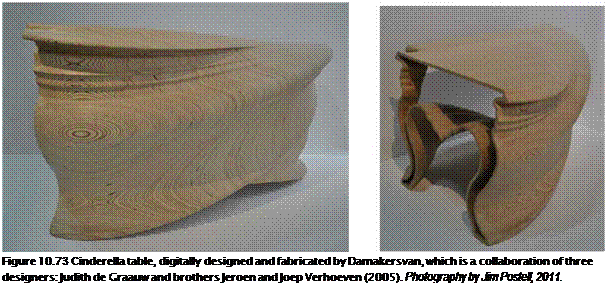Digital milling machines, high-end computer technologies, intuitive three-dimensional computer-aided design drawing (CADD) modeling programs, new synthetics, and smart materials are helping designers and fabricators realize new furniture products. In addition to the assimilation of digital technologies, green design has become a significant, almost an inherent, aspect of design. We have seen and will continue to see new designs respond to the growing need to respect our physical and social environments.
Damakersvan (translated to "The Makers of. . .") is a result of the collaboration of three designers: Judith de Graauw and brothers Jeroen and Joep Verhoeven. In 2005, the designers utilized computer-assisted design and fabrication technologies to create Table Cinderella (Figures 10.73 and 10.74). The table’s design is based on simplified drawings of seventeenth – and eighteenth-century French furniture from the archives of the Rijksmuseum in Amsterdam. The computer-generated model was divided into 57 digital slices, and each slice was then fabricated from 80-mm plywood using a numerically controlled multiaxial milling machine. The 57 slices were assembled and glued by hand at the designer’s studio in Rotterdam. The table consists of 741 layers of plywood.

Contemporary furniture designers seek to reveal new functional and utilitarian uses through the exploration and investigation of form, technology, and materials. The essence of invention depends on design thinking, as well as understanding how to interweave material and fabrication technologies with social use and formal aspiration. Today, more than at any other time in history, designers have the capacity to extend the parameters of furniture
Figure 10.74 Cinderella table (2005), view showing laminated and digitally milled plywood. Photography by Jim Postell, 2011.
The Twenty-First Century: The Digital Age 359
design into new societal and formal realms. This thought brings the reader back to the premise and opening remarks presented in the first chapter of this book:
Furniture design is deeply rooted in the human condition. It is a social science that belongs to the humanities, an applied art that draws upon many design fields, and a tangible reality that relies upon a working knowledge of materials and fabrication techniques. It is a holistic and all-embracing field of study.
ENDNOTES
1. www. thinkexist. com. Quotation by William Morris (1834-1896), British craftsman, early socialist, designer and poet, whose designs generated the Arts and Crafts movement in England.
2. Alvar Aalto, The Complete Works, Volume III (Zurich: Les Editions d’Architecture Artemis, Girsberger, 1963), p. 220.
3. Peter Philip, "Early Furniture," Sotherby’s Concise Encyclopedia of Furniture (New York: Harper & Row, 1989), Chapter 1, p. 14; Eternal Egypt web site: The Eternal Egypt, 2005. "Building Tools," www. eternalegypt. org.
4. Interview with Professor Dan Swarth, Copenhagen, Denmark, June 13, 2006.
5. Leon Battista Alberti, Book 6, "On Ornament," Part 2, On the Art of Building in Ten Books, translated by Joseph Rykwert, Neil Leach, and Robert Tavernor (Cambridge, MA: MIT Press, 1991).
6. William Hogarth, The Analysis of Beauty (London: Printed by J Reeves for the author, 1753); See also Bernd Krysmanski, "Upsetting the Balance: William Hogarth and Roger de Piles," The Site for Research on William Hogarth, updated February 2005: www. fortunecity. de/lindenpark/hundert- wasser/517/balance. html.
7. Megan Aldrich, Victor Chinnery, Leslie Keno, Noel Riley, and William Stahl, "The Baroque," in Sotherby’s Concise Encyclopedia of Furniture, Chapter 3, p. 56.
8. Hermann Muthesius (Das Englische Haus: Entwicklung, Bedingungen, Anlage, Aufbau, Einrichtung und innenraum. Bd. pp. 1-3. Berlin 1904-1905).
9. Gillian Naylor, The Arts and Crafts Movement (London: Trefoil, 1990 [first published 1971]), p. 7.
10. Stephen Gray and Robert Edwards, Collective Works of Gustav Stickley (New York: Turn of the Century Editions, 1981), p. 17.
11. Quote from August Endell, on a sign-plaque within the furniture exhibit at the MOMA (July, 2011).
12. Wolf von Eckardt, "The Bauhaus," Horizon, IV(2) (November 1961), p. 58.
13. David Pye, The Nature and Art of Workmanship (New York: Cambridge University Press, 1968), pp. 13-14.
14. Ibid




